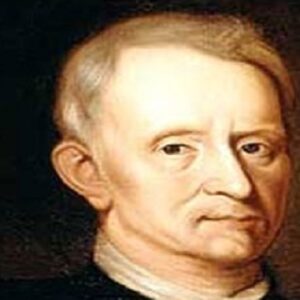Robert Hooke FRS was an English scientist, architect, and polymath. His name is somewhat obscure, and no portrait of him survives today, in part due to his rivalry with Sir Isaac Newton, his more famous and influential colleague. Nonetheless, he is credited with major contributions to science in the 17th century through his experimental and theoretical work, as well as his role in rebuilding London following the Great Fire of 1666. Always prone to illness, he never let it get in the way of his boundless interests. His experiments and studies spanned numerous disciplines, including physics, astronomy, chemistry, biology, geology, architecture, and naval technology. His ability to collaborate with scientists such as Christian Huygens, Antony van Leeuwenhoek, Christopher Wren, Robert Boyle, and Sir Isaac Newton enabled him to work alongside them. He discovered what is now known as Hooke’s law, the law of elasticity. He constructed a compound microscope and used it to observe the natural world’s tiniest, previously unseen details. He also concluded that fossils were once living creatures and that all celestial bodies were subject to gravity. However, despite his numerous contributions to science and humanity, he never received the recognition he deserved.
Childhood & Early Life
Robert Hooke was born on 28 July 1635 in Freshwater, England, to John Hooke and Cecily Gyles. His father was a minister at the Church of England and the curate of the Freshwater’s Church of All Saints. Robert had three siblings.
He acquired much of his education at home due of his ongoing weak health. But he amazed his father with his quick learning, drawing and painting skills and adeptness in building mechanical models.
His father passed away in 1648 and left him an inheritance of £40. With this he proceeded to London and gained an art apprenticeship under Peter Lely and Samuel Cowper. But he quit the apprenticeship soon and went to the Westminster School to study under Dr Richard Busby. He studied Greek, Latin, mechanics and mathematics.
Career of Robert
In 1655, Robert Hooke became an assistant to the great scientist Robert Boyle and served in this capacity through 1662. He helped in the construction and operation of Boyle’s air-pump.He discovered the law of elasticity which subsequently came to be known as Hooke’s Law. He defined this law in an anagram ‘ceiiinosssttuv’ in 1660 and presented its solution in 1678.
In 1660, the Royal Organisation—the oldest national scientific society in the world—was created by 12 individuals at the Gresham College. Some of them were Robert Boyle, Christopher Wren, John Wilkins, Sir Robert Moray and Viscount Brouncker. In 1662, on Sir Moray’s recommendation and with Boyle’s cooperation Hooke was named as the curator of the society. In 1663, he was elected a fellow of the society.
In 1664, he succeeded Arthur Dacres as the Gresham College’s professor of geometry.In 1665, he released the book ‘Micrographia,’ in which he detailed his observations using several microscope lenses. It is widely regarded as one of the most influential scientific works ever written.In the 1670s, he proposed that all celestial bodies are subject to gravitational influence. He said that it decreases with distance and that without it, the body would gravitate toward a straight line. However, he provided no evidence to support this.
By developing pendulum clocks, he made a significant contribution to timekeeping. He devised the anchor escapement, a cog that provided a tiny push for each pendulum swing while also moving the clock hands forward. He invented the balance spring for pocket watches.After examining the microscopic structure of a cork tree’s bark, Hooke developed the term ‘cell’ to refer to living beings, naming it after the cells occupied by Christian monks in a monastery.
He postulated that burning required a particular component of air, and that the same was true for respiration. According to experts, had he pursued his experiments further, he would have discovered oxygen.He believed that fossilised artifacts were the remains of living beings that had been immersed in mineral-laden petrifying water and were critical clues to the earth’s former history of life. He even suspected that a few of them might be extinct species.
In astronomy, Robert Hooke examined the Pleiades star cluster, the moon’s craters, Saturn’s rings, and the Gamma Arietis double-star system.
In 1682, he offered a unique mechanical model of human memory, including the encoding, memory capacity, repetition, retrieval, and forgetting components.He was also an architect who served as London’s Surveyor. He assisted in the reconstruction of the city following the Great Fire of 1666, co-designing the Monument of the Fire, the Royal Greenwich Observatory, Montagu House, Bethlem Royal Hospital, the Royal College of Physicians, Ragley Hall, Ramsbury Manor in Buckinghamshire, and the St Mary Magdalene church.
His Significant Works
Robert Hooke is primarily known for proposing the eponymous law of elasticity. He expressed the law for the first time in 1660 as a Latin anagram and published the answer in 1678. This law is widely applied in all sectors of science and engineering, and it serves as the foundation for a number of disciplines, including seismology, molecular mechanics, and acoustics.
Additionally, he is well-known for his observations acquired while using a microscope. In his 1665 work ‘Micrographia,’ he described experiments he conducted with a microscope. He invented the term “cell” in this ground-breaking work while describing the structure of cork.
Personal History and Legacies
He was afflicted with a variety of diseases during the final years of his life. On 3 March 1703, he died in London and was buried at St Helen’s Bishopsgate. At the time of his death, he was extremely wealthy.Throughout history, he has been described as a suspicious, envious, gloomy, and despotic human being. However, the discovery of his personal diary elicited the revelation of his emotional side.
Estimated Net Worth
Robert Hooke net worth or net income is estimated to be between $1 Million – $5 Million dollars. He has made such amount of wealth from his primary career as Philosopher.


